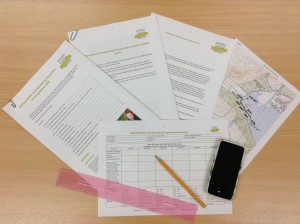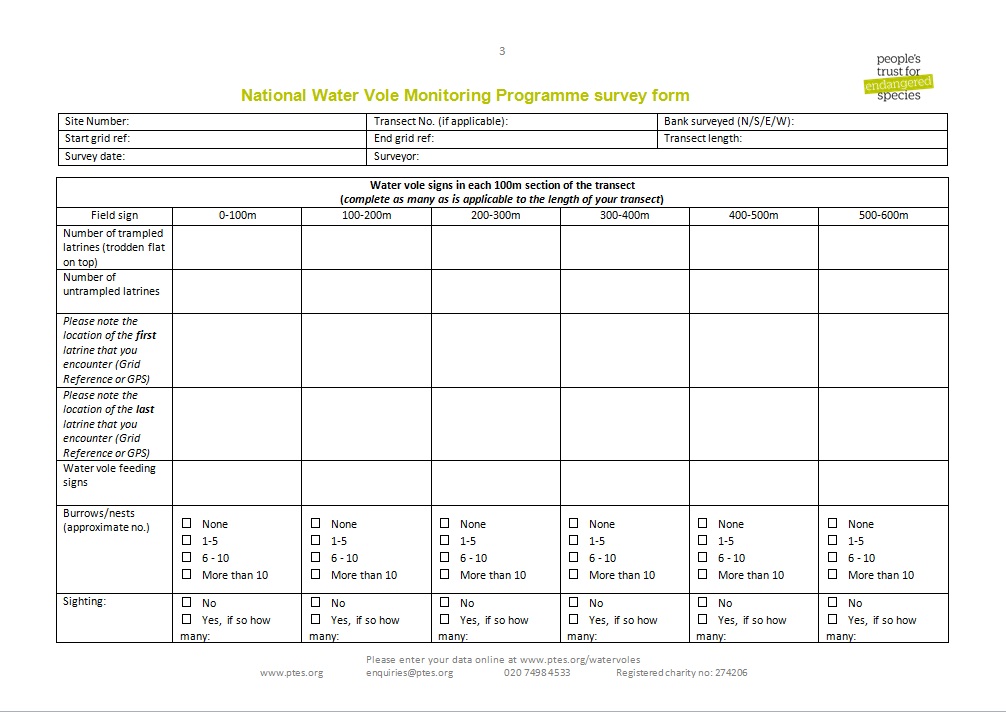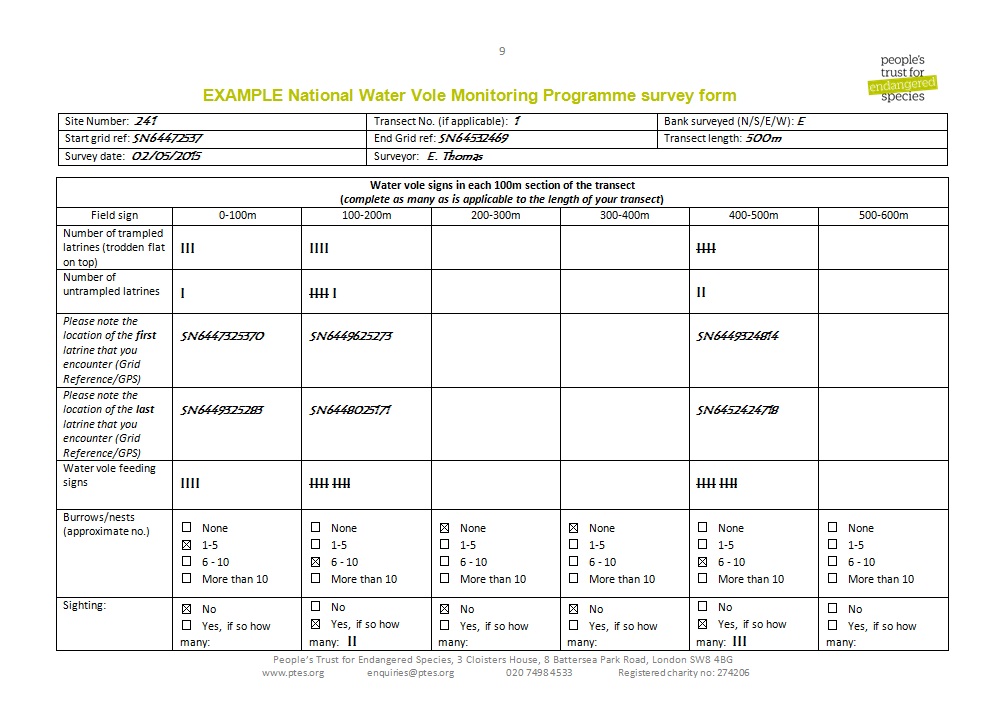Carrying out your survey
- + Timing your survey
- You must survey your site between 15th April and 15th June. This will ensure we collect information on pre-breeding numbers, before the females start to give birth, and allow us to compare data gathered from all the different sites.
- Surveys can be conducted on any day between 15th April and 15th June and at any time of the day. Your survey should take about 45 mins – 1 hour to complete.
- Surveys should not be conducted during times of flooding or heavy rain. Please wait at least two days after the water levels have subsided to allow field signs to accumulate and be visible.
- Optional: You may repeat the survey during September (post breeding) or more frequently if you wish, visiting your site once a month between May and September to record any field signs.
- + Equipment checklist
Please take with you:
- A map of your survey site with your transect, including the 100m sections, marked on it
- The survey pack (consisting of the following three documents):
- The survey guidelines

- Your guide to looking for signs of water voles and other riverbank species
- The NWVMP Recording forms
- A pen/pencil
- A spare landowner permission letter in case you are asked about the survey
- A fully charged mobile phone
The following equipment may also be useful:
- A stout pair of gloves e.g. gardening gloves
- A walking pole or stout stick may be useful for looking through dense vegetation
- Binoculars can also be useful for checking signs on the opposite bank or places that are difficult to access
- A ruler to measure lengths of field signs and to use to show scale in any photos
- Camera/ phone to take pictures of signs
- + Doing your survey
- Before starting you survey, ensure you complete the top section of your survey form with this information, as shown in the image:
- the site number
- the transect number (if you are surveying more than one transect at your site)
- the bank you will be surveying
- the start and end grid references
- the date

- Locate the start of your transect.
- Start walking along your transect
- Walk as close to the water’s edge as possible (while remaining safe). Carry out a continuous search for field signs (latrines, feeding signs, burrows/nests and sightings – please see Your guide to looking for signs of water voles and other riverbank species document) along your 500m transect.
- If the bankside vegetation is particularly dense and a continuous metre by metre search is not possible then “scallop” the bank – go to the water’s edge at 2m intervals and sample up to 0.5m each side of the sampling point. (If this method is used make sure that it is noted on the data sheet).
- In each 100m section of your transect keep a tally of feeding signs (each pile of chopped vegetation counts as one), latrines (trampled and untrampled), burrows/nests and sightings on your survey form. If you are able to take photographs of the field signs to submit with your data, please do so.
- The grid reference/GPS position of the first and last latrine in each 100m length must be recorded as a minimum (see Box 2. for more details).

- Mink and otter signs
- If you see signs of otter (spraint/sightings) or mink (scats/sightings) and are certain of your identification, please record them in the mink and otter signs section of the recording form.
- Please try to take a photo of the field sign, ideally with a ruler beside it for scale and upload these when you submit your data so that they can be verified.
Grid references for field signs
As a minimum you must record the grid reference/GPS position of the first and last latrine in each 100m length along your transect if water voles are present.
This will allow us to determine the length of waterway occupied by water voles and as we know the approximate length of waterway a water vole will use as its territory we can estimate abundance of water voles as well as presence.
Optional
If you would like to also record the position of all the field signs in each 100m length then this will give an even better indication of abundance of water voles on your transect.
If you would like to do this, you will need to fill in the ‘Field signs recording form’, making a note of what type of field sign it was, its position, which 100m length of transect it was in and any comments about the field sign.
- + Health and safety
A comprehensive version of People’s Trust for Endangered Species Health and Safety guidelines, including a Risk Assessment form, can be found here. Please ensure you read through them before carrying out your survey.
Essential health and safety points to remember when conducting your survey:
- Always work in pairs if possible
- Ensure you wear appropriate clothing (i.e. warm and waterproof) and suitable footwear
- Always tell someone of your expected return time with a maximum over-run of 30 minutes
- If working on a reserve, always tell site staff when and where you are working on the site and inform them when you leave the site
- Always carry a charged mobile phone
- Never work in extreme weather conditions
- Cover all cuts and broken skin with a waterproof plaster or liquid skin to prevent the transmission of Leptospirosis/Weil’s Disease.
Leptospirosis/Weil’s disease
Please make sure you consult the Health and Safety Executive website before surveying.
Weil’s disease is caused by a bacterial organism carried in the kidneys of rodents which is passed into water by their urine. The main routes of infections are through cuts and grazes, and the nose, eyes and mouth. Early symptoms can be confused with flu i.e. pains in joints and muscles, elevated temperature, headache. Later symptoms include bruising of the skin, sore eyes, nose bleeds and jaundice. If you suspect Weil’s disease show a copy of the HSE Leptospirosis card to your doctor immediately. The disease can be fatal.
- + Completing your survey
Please ensure all relevant sections of the paper recording forms are completed when you finish walking your transect and make a note of any signs you took photos of.

If there is only one transect at your site then you have finished your survey.
If you are surveying more than one transect please proceed by a safe route to the next transect at the site and begin again.
Download a printable version of these guidelines:
More useful downloads
- NWVMP Recording forms
- Your guide to looking for signs of water voles and other riverbank species
- Land Owner Questionnaire Pack
Next: After your survey
Training menu:
• An introduction to the NWVMP
• Planning your survey
• Searching for field signs
• Carrying out your survey
• After your survey
• More training links
Feedback – we would really value your feedback on these training pages and also on the monitoring programme. Please email any comments to watervoles@ptes.org.
